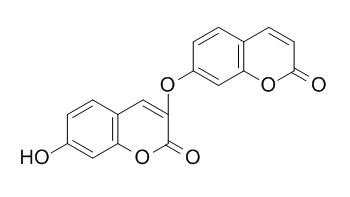Edgeworin
Edgeworin is a DNA polymerase beta (pol beta) inhibitor, it inhibits both the lyase and polymerase activities of DNA polymerase beta; it can potentiate the inhibitory action of the anticancer drug bleomycin in cultured A549 cells via an inhibition of DNA repair synthesis.
Inquire / Order:
manager@chemfaces.com
Technical Inquiries:
service@chemfaces.com
Tel:
+86-27-84237783
Fax:
+86-27-84254680
Address:
1 Building, No. 83, CheCheng Rd., Wuhan Economic and Technological Development Zone, Wuhan, Hubei 430056, PRC
Providing storage is as stated on the product vial and the vial is kept tightly sealed, the product can be stored for up to
24 months(2-8C).
Wherever possible, you should prepare and use solutions on the same day. However, if you need to make up stock solutions in advance, we recommend that you store the solution as aliquots in tightly sealed vials at -20C. Generally, these will be useable for up to two weeks. Before use, and prior to opening the vial we recommend that you allow your product to equilibrate to room temperature for at least 1 hour.
Need more advice on solubility, usage and handling? Please email to: service@chemfaces.com
The packaging of the product may have turned upside down during transportation, resulting in the natural compounds adhering to the neck or cap of the vial. take the vial out of its packaging and gently shake to let the compounds fall to the bottom of the vial. for liquid products, centrifuge at 200-500 RPM to gather the liquid at the bottom of the vial. try to avoid loss or contamination during handling.
J of Liquid Chromatography & Related Technologies2024, 47(1-5):14-25.
Molecules.2022, 27(22):7997.
Appl. Sci.2020, 10(5),1713.
Int J Mol Sci.2023, 24(8):7442.
Front Pharmacol.2022, 13:919230.
Postharvest Biol Tec2019, 149:18-26
Appl. Sci. 2021, 11(10),4666.
Molecules.2023, 28(2):727.
Nutraceutical Research . 2021, 19(1),p90-105.
Industrial Crops and Products2024, 219:119123
Related and Featured Products
Bioorg Med Chem. 2008 Apr 15;16(8):4331-40.
Inhibitors of DNA polymerase beta: activity and mechanism.[Pubmed:
18343122 ]
METHODS AND RESULTS:
Bioassay-guided fractionation of extracts prepared from Couepia polyandra and Edgeworthia gardneri resulted in the isolation of the DNA polymerase beta (pol beta) inhibitors oleanolic acid (1), Edgeworin (2), betulinic acid (3), and stigmasterol (4). Study of these pol beta inhibitors revealed that three of them inhibited both the lyase and polymerase activities of DNA polymerase beta, while stigmasterol inhibited only the lyase activity. Further investigation indicated that the four inhibitors had substantially different effects on the DNA-pol beta binary complex that is believed to be an obligatory intermediate in the lyase reaction. It was found that the inhibitors potentiated the inhibitory action of the anticancer drug bleomycin in cultured A549 cells, without any influence on the expression of pol beta in the cells.
CONCLUSIONS:
The results of the unscheduled DNA synthesis assay support the thesis that the potentiation of bleomycin cytotoxicity by DNA pol beta inhibitors was a result of an inhibition of DNA repair synthesis.
Biol Pharm Bull. 2004 Aug;27(8):1312-6.
Antiproliferative constituents in plants 14. Coumarins and acridone alkaloids from Boenninghausenia japonica NAKAI.[Pubmed:
15305045]
METHODS AND RESULTS:
The MeOH extracts of the ground part and the root of Boenninghausenia japonica NAKAI showed inhibitory activity against tumor cell growth. Fractionation of the extracts has resulted in isolation of 1,3-dihydroxy-4-(2'-hydroxy-3'-hydroxymethyl-3',4'-epoxy-butyl)-N-methylacridone, 1,3-dihydroxy-4-[(Z)-3'-hydroxy-3'-methyl-buten-1'-yl]-N-methylacridone, 3-(1',1'-dimethylallyl)-7-hydroxy-8-methoxy-2H-1-benzopyran-2-one, casegravol, cis-casegravol, and Edgeworin in addition to 9 compounds reported from B. japonica and B. albiflora.
CONCLUSIONS:
The isolates from this plant and some related compounds were tested for antiproliferative activity against human gastric adenocarcinoma (MK-1), human uterus carcinoma (HeLa), and murine melanoma (B16F10) cells.



